The Ultimate Guide to Industrial Tunnel Microwave Grain Drying and Sterilizing Machines in 2024
Introduction
Welcome to the ultimate guide on Industrial Tunnel Microwave Grain Drying and Sterilizing Machines in 2024. In this comprehensive overview, we'll delve into the innovative technology behind industrial tunnel microwave machines, exploring their operational principles, advantages, applications, and future trends.
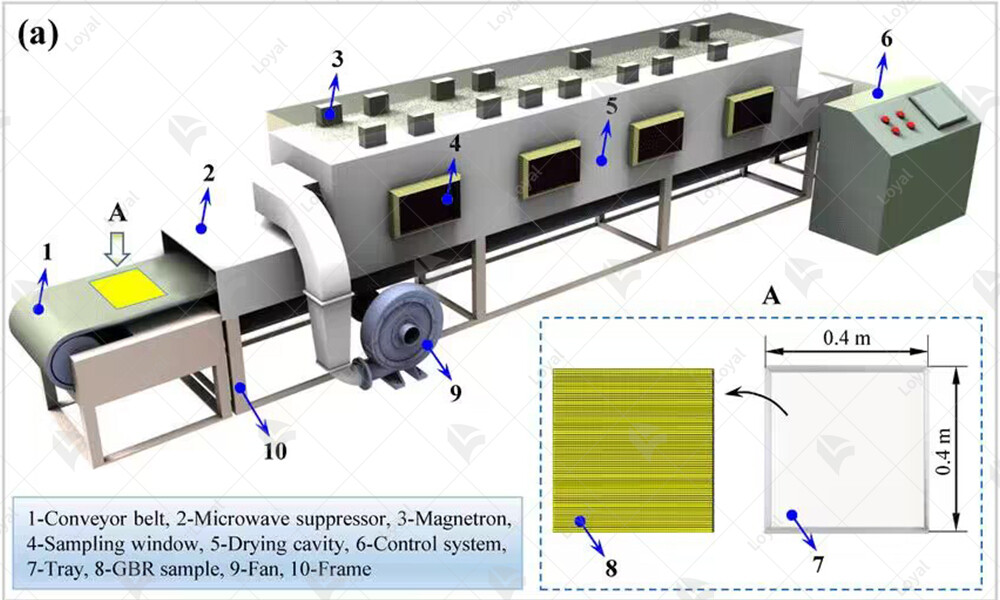
Working Principle of Industrial Tunnel Microwave Grain Drying and Sterilizing Machine
The working principle of an industrial tunnel microwave grain drying and sterilizing machine is rooted in the fundamental properties of microwave technology. These machines leverage electromagnetic waves within the microwave frequency range to heat and sterilize grains effectively.
Microwave technology operates on the principle of dielectric heating, wherein materials with high dielectric properties, such as water, are heated when exposed to microwave radiation. In the case of grain drying and sterilization, the moisture content within the grains serves as the primary medium for absorbing microwave energy.
Within the industrial tunnel microwave machine, grains are conveyed through a tunnel-like chamber equipped with microwave-emitting components. As the grains pass through this chamber, they are exposed to intense microwave radiation. The microwave energy penetrates the grains, causing rapid and uniform heating throughout the material.
The heating process facilitates the evaporation of moisture present in the grains, leading to efficient drying. Additionally, the thermal energy generated by the microwaves results in the sterilization of the grains by effectively destroying harmful microorganisms, pathogens, and insect pests.
Key components of an industrial tunnel microwave grain drying and sterilizing machine include microwave generators, waveguides, and conveyor systems. Microwave generators produce the electromagnetic waves necessary for heating, while waveguides channel and direct the microwaves into the processing chamber. Conveyor systems ensure the continuous movement of grains through the machine, allowing for consistent and thorough treatment.
Overall, the working principle of industrial tunnel microwave grain drying and sterilizing machines offers a highly efficient and rapid method for processing grains while preserving their quality and safety. Through the precise application of microwave technology, these machines enable industries to meet stringent standards for grain drying and sterilization in a cost-effective and environmentally friendly manner.
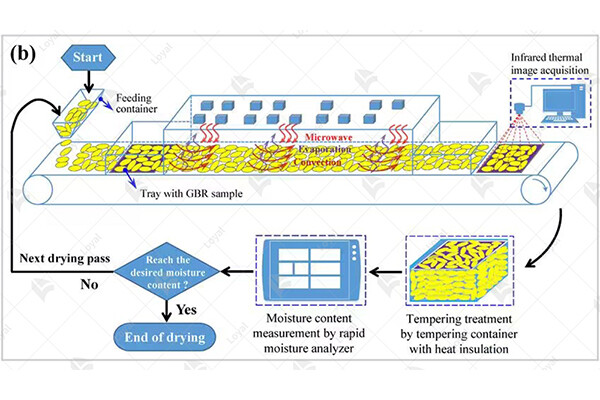
Key components of industrial tunnel microwave machine
Component | Description |
Microwave Generator | The heart of the system, generates microwaves used for drying and sterilization processes. |
Magnetron | Produces microwave radiation by converting electrical energy into electromagnetic waves. |
Waveguide | Transmits microwave energy from the generator to the processing chamber. |
Processing Chamber | Enclosed space where grains are exposed to microwave radiation for drying and sterilization. |
Conveyor System | Moves grains through the processing chamber, ensuring uniform exposure to microwaves. |
Temperature Sensors | Monitor and control the temperature inside the processing chamber to optimize drying conditions. |
Control Panel | Interface for operators to set parameters such as temperature, power level, and processing time. |
Exhaust System | Removes moisture and gases released during the drying and sterilization process. |
Safety Interlocks | Prevents unauthorized access to the processing chamber and ensures operator safety. |
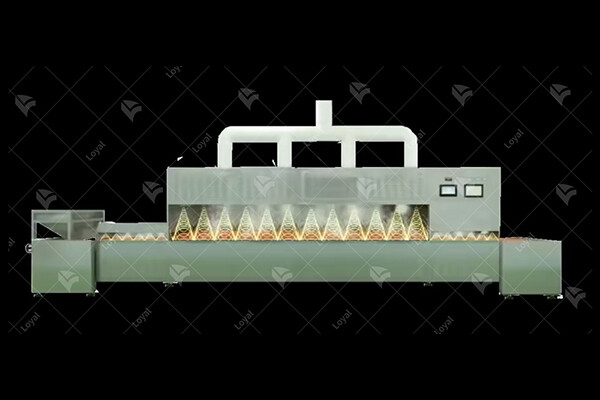
Advantages and Disadvantages of Industrial Tunnel Microwave Grain Drying and Sterilizing Machine
Advantages | Disadvantages |
1. Rapid Drying: Industrial tunnel microwave machines offer rapid drying capabilities, significantly reducing drying times compared to traditional methods. | 1. Initial Investment: The upfront cost of purchasing and installing industrial tunnel microwave machines can be higher compared to conventional drying equipment. |
2. Energy Efficiency: Microwave technology consumes less energy compared to other drying methods, leading to reduced operational costs and environmental impact. | 2. Limited Penetration Depth: Microwave energy has limited penetration depth, which may result in uneven drying or sterilization if not properly managed. |
3. Enhanced Sterilization: Microwaves effectively sterilize grains by targeting harmful microorganisms without compromising product quality. | 3. Product Sensitivity: Some grains may be sensitive to microwave radiation, leading to potential quality issues if not carefully monitored during processing. |
4. Preserves Nutritional Value: Industrial tunnel microwave drying preserves the nutritional content of grains better than conventional drying methods, ensuring higher product quality. | 4. Technical Expertise Required: Operating and maintaining industrial tunnel microwave machines requires specialized technical knowledge, which may pose challenges for some operators. |
5. Space-saving Design: Industrial tunnel microwave machines are often compact and require less floor space compared to traditional drying equipment, optimizing facility layout. | 5. Potential Safety Hazards: Improper handling of microwave equipment can pose safety hazards to operators, requiring strict adherence to safety protocols. |
6. Versatility: These machines can be customized to accommodate various grain types and processing requirements, offering flexibility in production. | 6. Limited Scalability: Scaling up production with industrial tunnel microwave machines may require significant investment in additional equipment and infrastructure. |
7. Reduced Labor Costs: Automated operation and control systems minimize the need for manual labor, reducing labor costs and improving efficiency. | 7. Regulatory Compliance: Compliance with regulatory standards and guidelines for microwave food processing may necessitate additional validation and documentation. |
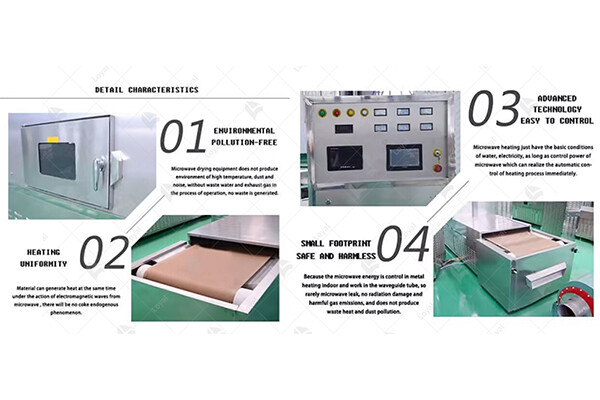
Comparison and advantages of microwave technology and traditional sterilization methods
Aspect | Industrial Tunnel Microwave Grain Drying and Sterilization Machine | Traditional Sterilization Methods |
Sterilization Efficiency | Utilizes microwave energy to rapidly and effectively sterilize grains, achieving high levels of microbial reduction. | Typically involves prolonged exposure to high temperatures or chemicals, which may not completely eliminate all microbial contaminants. |
Energy Consumption | Generally consumes less energy compared to traditional methods due to shorter processing times. | Often requires significant energy input, especially for heating large volumes of grains over extended periods. |
Nutrient Retention | Preserves the nutritional quality of grains by minimizing heat exposure during sterilization. | May result in degradation of certain nutrients due to prolonged heating or chemical treatments. |
Processing Speed | Offers rapid processing times, allowing for high throughput and faster production cycles. | May involve slower processing times, especially for methods like steam or chemical sterilization. |
Environmental Impact | Generally considered more environmentally friendly due to reduced energy consumption and minimal chemical usage. | May have a higher environmental impact, particularly if chemical sterilants are used and not properly disposed of. |
Equipment Maintenance Needs | Requires regular maintenance but typically has fewer moving parts and simpler operation compared to traditional equipment. | May require more frequent maintenance due to complex machinery and potential wear and tear from prolonged use. |
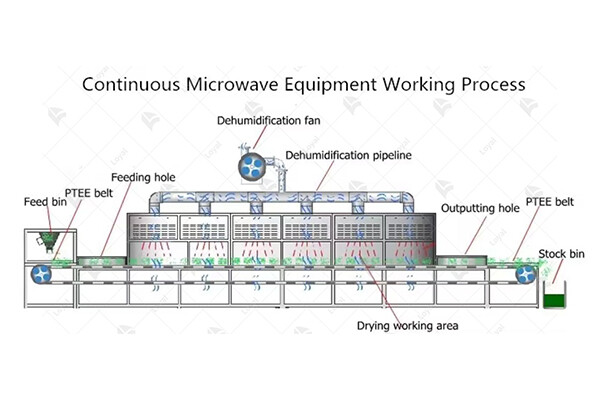
Types of Industrial Tunnel Microwave Grain Drying and Sterilizing Machines
Type of Machine | Description |
Batch Tunnel Dryers | These machines process grains in batches, where a specific quantity of grains is loaded at once and subjected to microwave drying and sterilization. They are suitable for smaller-scale operations and offer flexibility in processing various grain types. |
Continuous Tunnel Dryers | Continuous tunnel dryers are designed for large-scale grain processing operations. They feature a conveyor belt system that continuously feeds grains through the tunnel, allowing for continuous drying and sterilization. They are highly efficient and ideal for high-volume production needs. |
Hybrid Tunnel Dryers | Hybrid tunnel dryers combine microwave technology with other drying methods such as hot air or infrared heating. This hybrid approach enables faster and more uniform drying while reducing energy consumption. They are versatile and can be customized based on specific processing requirements. |
Vacuum Microwave Dryers | Vacuum microwave dryers utilize both microwave energy and vacuum conditions to dry grains. By reducing the air pressure inside the chamber, these machines lower the boiling point of water, facilitating faster drying while preserving the quality of grains. They are particularly suitable for heat-sensitive products and delicate grains. |
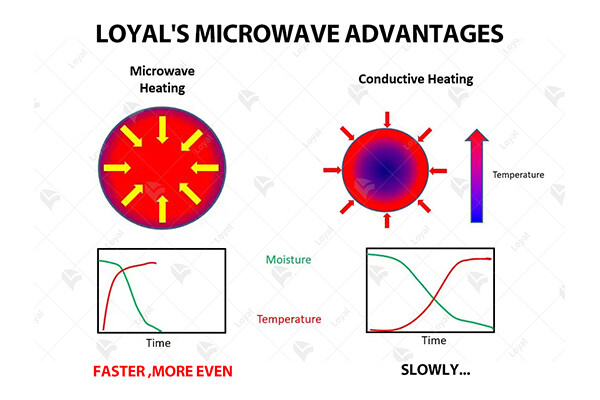
Technical parameters
| Technical Parameters Of Continuous Microwave Dryer Industrial Microwave Drying Machine | |||||
| Model | Size LWH(Can be customized according to the customer's requirements) | Output power | Dewaterability | Sterilization capacity | Baking and Roasting capacity (Depends on different raw material) |
| LY-10KW | 5000mm825mm1750mm | ≥10KW | 10KG/Hour | 100KG/Hour | 30-50KG/Hour |
| LY-20KW | 8000mm825mm1750mm | ≥20KW | 20KG/Hour | 200KG/Hour | 60-100KG/Hour |
| LY-30KW | 8500mm1160mm1750mm | ≥30KW | 30KG/Hour | 300KG/Hour | 90-150 KG/Hour |
| LY-40KW | 10000mm1160mm1750mm | ≥40KW | 40KG/Hour | 40KG/Hour | 120-200KG/Hour |
| LY-50KW | 12500mm1160mm1750mm | ≥50KW | 50KG/Hour | 500KG/Hour | 150-250KG/Hour |
| LY-60KW | 13500mm1450mm1750mm | ≥60KW | 60KG/Hour | 600KG/Hour | 180-300KG/Hour |
| LY-70KW | 13500mm1500mm1750mm | ≥70KW | 70KG/Hour | 700KG/Hour | 210-350KG/Hour |
| LY-80KW | 13500mm1650mm1750mm | ≥80KW | 80KG/Hour | 800KG/Hour | 240-400KG/Hour |
| LY-100KW | 16800mm1650mm1750mm | ≥100KW | 100KG/Hour | 1000KG/Hour | 300-500KG/Hour |
| LY-150KW | 22400mm1850mm1750mm | ≥150KW | 150KG/Hour | 1500KG/Hour | 450-750KG/Hour |
| LY-200KW | 27000mm1850mm1750mm | ≥250KW | 250KG/Hour | 2500KG/Hour | 750-1250/Hour |
| LY-300KW | 32000mm1850mm1750mm | ≥300KW | 300KG/Hour | 3000KG/Hour | 900-1500KG/Hour |
| Power Supply | 380V±10% 50Hz±1% Three-Phase Five-Wire | ||||
| Microwave Output Frequency | 2450±50Mhz | ||||
| Microwave Input Apparent Power | ≤168Kva | ||||
| Microwave Output Power | ≥120Kw | ||||
| Microwave Power Adjustment Range | 0-30Kw(Adjustable) | ||||
| Ambient Temperature | -5-40°C | ||||
| Relative Humidity | ≤80%, Surrounding Environment:No Corrosive Gas, Conductive Dust And Explosive Gas | ||||
| Transmission Speed | 0-10m/Min(Adjustable) | ||||
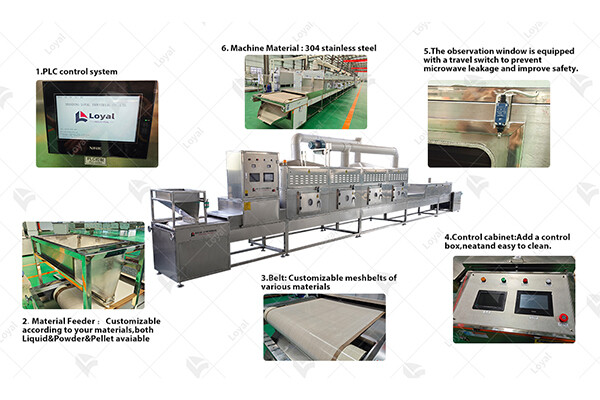
Application of industrial tunnel microwave grain drying and sterilizing machine
Application | Description |
Food Processing | Industrial tunnel microwave grain drying and sterilization machines are extensively used in the food processing industry to enhance food safety and quality. These machines efficiently remove moisture from grains while simultaneously sterilizing them, ensuring the elimination of harmful pathogens such as bacteria and fungi. By utilizing microwave technology, food manufacturers can achieve rapid and uniform drying and sterilization, preserving the nutritional value and flavor of the grains. Moreover, the precise control offered by these machines allows for customization of drying and sterilization parameters, catering to different types of grains and production requirements. Overall, the application of industrial tunnel microwave grain drying and sterilization machines in food processing ensures product consistency, prolongs shelf life, and meets stringent food safety standards. |
Agriculture | In the agricultural sector, industrial tunnel microwave grain drying and sterilization machines play a crucial role in post-harvest processing. Farmers and grain handlers utilize these machines to efficiently dry and sterilize freshly harvested grains, preventing spoilage and maintaining grain quality during storage and transportation. Traditional drying methods such as sun drying are often time-consuming and can lead to quality deterioration due to exposure to unfavorable weather conditions. However, with industrial tunnel microwave machines, grains can be dried and sterilized within a short period, minimizing the risk of mold growth and mycotoxin contamination. This not only ensures better marketability of grains but also reduces post-harvest losses, contributing to higher profitability for farmers. |
Pharmaceuticals | Industrial tunnel microwave grain drying and sterilization machines find application in the pharmaceutical industry for the processing of medicinal herbs and botanical extracts. These machines offer a rapid and efficient method for drying and sterilizing plant materials, ensuring the preservation of bioactive compounds and eliminating microbial contamination. By utilizing microwave technology, pharmaceutical manufacturers can achieve precise control over drying parameters such as temperature and moisture content, minimizing degradation of sensitive active ingredients. Moreover, the uniform heating provided by industrial tunnel microwave machines results in consistent product quality and potency, meeting regulatory requirements for pharmaceutical products. Overall, the application of these machines in pharmaceutical processing enhances product safety, efficacy, and shelf stability, thereby benefiting both manufacturers and consumers. |

Technological Progress and Innovation of Industrial Tunnel Microwave Grain Drying and Sterilizing Machine
Technological Progress and Innovation of Industrial Tunnel Microwave Grain Drying and Sterilizing Machine
In the landscape of modern food processing, the Industrial Tunnel Microwave Grain Drying and Sterilization Machine stands out as a pinnacle of innovation and efficiency. This cutting-edge equipment combines the power of microwave technology with the precision of industrial-scale machinery, revolutionizing the way grains are processed and preserved.
At its core, the Industrial Tunnel Microwave Grain Drying and Sterilization Machine harnesses the power of microwaves to rapidly and uniformly dry and sterilize grains. Unlike traditional methods that rely on heat transfer through conduction or convection, microwave technology penetrates the grain kernels, heating them from within. This not only accelerates the drying and sterilization process but also preserves the nutritional integrity and flavor profile of the grains.
One of the key technological advancements in these machines is their precise control and monitoring systems. Advanced sensors and automation algorithms ensure that the drying and sterilization process is carried out with utmost precision, minimizing energy consumption and maximizing throughput. This level of control not only improves the quality of the end product but also reduces operational costs for manufacturers.
Furthermore, ongoing research and development efforts are driving continuous innovation in industrial tunnel microwave technology. Engineers and scientists are exploring ways to further enhance the efficiency and effectiveness of these machines. From optimizing microwave frequency and power settings to developing novel sterilization techniques, the quest for improvement is relentless.
In addition to their primary function of grain drying and sterilization, Industrial Tunnel Microwave Grain Drying and Sterilization Machines are finding new applications across various industries. From pharmaceuticals to cosmetics, the ability to efficiently and precisely control moisture content and microbial activity is invaluable. This versatility underscores the significance of these machines in the broader context of industrial processing.
Looking ahead, the future of Industrial Tunnel Microwave Grain Drying and Sterilization Machines is promising. As technology continues to evolve and consumer demands shift, manufacturers are poised to introduce even more advanced features and capabilities. Whether it's increased automation, integration with IoT platforms, or enhanced energy efficiency, the trajectory of innovation is clear.
In conclusion, the Industrial Tunnel Microwave Grain Drying and Sterilization Machine represents a convergence of technology, efficiency, and quality in the realm of grain processing. With ongoing advancements and innovations, these machines are poised to play an increasingly pivotal role in the food and manufacturing industries, shaping the way grains are processed and preserved for years to come.

Precautions for Selection and Implementation of Industrial Tunnel Microwave Grain Drying and Sterilizing Machine
Precaution | Description |
Capacity Requirements | Industrial tunnel microwave grain drying and sterilizing machines come in various capacities. It's crucial to assess your production needs accurately to choose a machine that can handle the volume of grains you process efficiently. Ensure that the selected machine has the capacity to meet both current and future demands. |
Energy Efficiency | Consider the energy efficiency of the machine to minimize operational costs and environmental impact. Look for machines equipped with advanced technology to optimize energy consumption during the drying and sterilization process. |
Equipment Quality | Prioritize the quality of components and construction of the machine. Opt for reputable manufacturers known for producing durable and reliable industrial tunnel microwave machines. Quality equipment ensures consistent performance and longevity, reducing the risk of downtime and maintenance issues. |
Regulatory Compliance | Ensure that the selected machine complies with industry regulations and safety standards. Verify certifications and documentation to guarantee the machine's adherence to safety guidelines for food processing and sterilization. Compliance with regulatory requirements is essential to maintain product quality and consumer safety. |
Technical Support and Training | Choose a supplier that offers comprehensive technical support and training services. Proper training for operators ensures the correct operation and maintenance of the machine, maximizing its efficiency and lifespan. Additionally, access to reliable technical support facilitates prompt troubleshooting and resolution of any issues that may arise during operation. |
Integration with Existing Systems | Assess compatibility and integration capabilities with existing production systems. Ensure that the selected machine can seamlessly integrate into your facility's workflow without causing disruptions or inefficiencies. Compatibility with other equipment and software enhances operational efficiency and facilitates streamlined grain processing. |
Cost Considerations | Evaluate the total cost of ownership, including upfront investment, operational expenses, and maintenance costs. While price is a factor, prioritize value and long-term benefits over initial savings. Consider factors such as energy efficiency, reliability, and after-sales support when determining the overall cost-effectiveness of the machine. |
Performance Monitoring and Optimization | Implement systems for monitoring and optimizing the performance of the industrial tunnel microwave machine. Utilize data analytics and automation tools to track key performance indicators and identify opportunities for improvement. Regularly assess and adjust operational parameters to ensure optimal drying and sterilization outcomes while minimizing waste and energy consumption. |
Reference
The following are five authoritative foreign literature websites in the field of industrial microwaves:
1. IEEE Xplore Digital Library
Website: [https://ieeexplore.ieee.org/]
2.ScienceDirect
Website: [https://www.sciencedirect.com/]
3. SpringerLink
Website: [https://link.springer.com/]
4. Wiley Online Library
Website: [https://onlinelibrary.wiley.com/]
5. PubMed
Website: [https://pubmed.ncbi.nlm.nih.gov/]
 Telephone :+86-531-55583139
Telephone :+86-531-55583139 WhatsApp :+86 13256674591
WhatsApp :+86 13256674591 Email :
Email :










